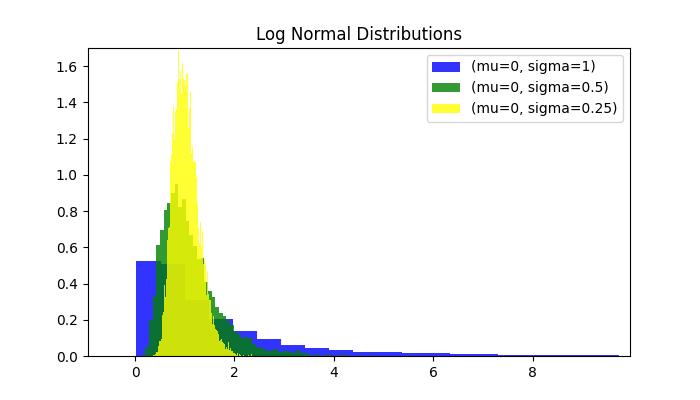Python 中的 random.lognormvariate() 方法生成遵循对数正态(对数正态)分布的随机数。此分布是随机变量的连续概率分布系列,其对数呈正态分布。
它取决于两个参数 mu 和 sigma,其中 mu 是平均值,sigma 是基础正态分布的标准差。
对数正态分布通常用于自然科学、工程、医学、经济学和其他领域。
这个函数不能直接访问,所以我们需要导入 random 模块,然后我们需要使用 random 静态对象调用这个函数。
语法
以下是 lognormvariate() 方法的语法 -
参数
Python random.lognormvariate() 方法采用两个参数 -
- mu:这是基础正态分布(对数正态分布的自然对数)的平均值。它可以采用任何实际价值。
- sigma:这是基础正态分布的标准差。它必须大于零。
返回值
这个 random.lognormvariate() 方法返回一个遵循 Log 正态分布的随机数。
示例 1
让我们看一个使用 random.lognormvariate() 方法从均值为 0 且标准差为 1 的正态分布中生成随机数的基本示例。
以下是输出 -
Generated random number from log normal distribution: 9.472544796309364
注意:由于程序的随机性,每次运行程序时生成的 Output 都会有所不同。
示例 2
此示例使用 random.lognormvariate() 方法生成一个包含 10 个随机数的列表,该列表遵循对数正态分布。
在执行上述代码时,您将获得如下所示的类似输出 -
List of random numbers from log normal distribution: [0.500329149795808, 1.7367179979113172, 0.5143664713594474, 0.5493391936855808, 1.3565058546966193, 1.4841135680348012, 0.5950837276748621, 0.8880005878135713, 1.0527856543498058, 0.7471389015523113]
示例 3
这是另一个使用 random.lognormvariate() 方法的示例,它演示了更改平均值和标准差如何影响正态分布的形状。
上述代码的输出如下 -




